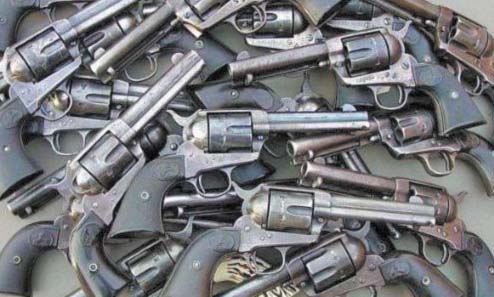The Maoists in Dandakaranya swear by it. The tribals in Bastar use it. The poachers in Tamil Nadu hunt with it and the gangs of Mumbai kill with it. From Kashmir to Kanyakumari, the trade in illegal, country-made weapons continues its climb. Power may not flow from the barrel of the gun in a democracy, but brazen displays of firepower by hired miscreants men are seeing a steep rise across the country, especially in the capital, New Delhi.
In early-2020, Delhi saw a spate of communal clashes in which nearly 53 people were killed . As many as 200 sustained severe injuries primarily from bullets and gunshots.
Many wondered how the gang leaders and miscreants managed to lay their hands on deadly guns so easily. The average Indian is completely ignorant of the hows and where-abouts of getting an illegal weapon.
Just two weeks after the Election Commission’s Model Code of Conduct (MCC) for the Delhi polls kicked in on 6 January, the police registering an average of 10 cases everyday against those carrying pistols, carbines, revolvers and live cartridges in public places without the requisite permits. It was found that rackets spanning from Meerut to Madhya Pradesh had stepped up manufacturing and supplies to Delhi, anticipating a surge in demand around the 8 February polling date.
The arms are used to display muscle power and intimidate voters and a hired muscleman is not intimidating enough without a gun in his armoury.
Between the 6 and 25 January 2020, 252 first information reports (FIR) had been lodged under the Arms Act, 273 people arrested, besides 335 weapons and 383 cartridges seized by the Delhi Police. These cases pertained to arms trafficking as well as seizures from dreaded gangsters and notorious criminals.
According to Delhi Police figures, more than 2,100 illegal arms were seized up to 15 September 2019. This is quite high as compared to 1,399 weapons seized till 15 September 2018. More than 559 cases had also been registered under the Arms Act up to 15 September 2019.
The menace or burgeoning of illegal weapons is not just limited to the capital though. In November 2019, Qadian in Gurdaspur district saw a shoot-out between two groups of students which resulted in the death of a woman and left the residents of the area in a state of shock. Being a border state that has lived through fractious days of militancy, as also being of an agrarian bent of economy, there is a justifiable call for protecting the land and its produce and the resulting need for possessing arms is, thereby, understandable. But what is of concern is the arguably unchequered access to illegal arms.
According to the National Crime Records Bureau, only 14 percent of the victims of gun violence in India in 2019 were killed by licensed guns. The rest were killed by illegal weapons, largely prevalent in the hinterlands and rural outlying areas. These are indeed worrying statistics.
The Firearms Trail
Production of illegal firearms in India, though a serious issue, does not receive due attention from the government and law enforcement officials. Indigenous weapons come at a far cheaper price compared to their market counterparts and even though their accuracy is suspect, they are highly destructive and impossible to trace back to their owners using ballistic fingerprinting.
Law and order system in the country has played a role in the flourishing illegal factories for many years now. This is not a recent phenomenon but was so even in colonial times. Since Independence, it has flourished and the volume has burgeoned.
Largely, this manufacturing had been ascribed to the states of UP and Bihar. UP is the undisputed leader when it comes to manufacturing of illegal firearms, followed closely by Bihar. In UP, large urban centres like Muzzaffarnagar, Ghaziabad, Rampur, Meerut, Etah, Azamgarh, Bulandshahar and areas near Loni on the Delhi-UP border have been identified as big trade centres for illicit guns. There are reports dating back to 2004 of a unit in Loni that used to sell over 30 firearms on an average every month and earn about Rs 50,000. Conflating it with the existing inflation figures, this statistic would have easily mounted to at least Rs 10 lakh per month, today.
Munger, a small town 250 km southeast of Patna is the capital of country-made weapons as well as the service centre of all illegal weapons produced in the country. Illegal gun-making is part of historical lore here. Skilled workers have been manufacturing these since before Independence. On custom orders, Munger can produce carved, ornate pieces apart from the usual crude ones. Over the years, Munger’s gun-makers have further perfected their skills. Today, the artisans and gunsmiths boast of having the ability to produce copies of such intricate weapons like the Beretta, the famed weapon of choice for James Bond as well as the feared AK-47 on demand.
In 2014, when an alleged Hizbul Mujahideen arms courier Ravesh Islam was arrested from Pathankot railway station, two pistols recovered from him were marked “Only for Army use” and “Made in US” respectively. They, in fact, came from factories in Munger. How did Munger earn its notorious moniker? Arms manufacturing began here in the early 18th Century when Mir Qasim, the then Nawab of Bengal commanded the artisans to make guns to fight the British.
Bundelkhand’s Jhansi and Madhya Pradesh’s Dhar, Burhanpur, Khargone are also known for being hubs for illegal arms manufacturing units.
The factories make every part, from side covers to butts, barrels and triggers using hand-powered drills, grinding and welding machines. The most commonly produced illegal models in India include the homegrown katas and tamanchas, duplicate pistols, Berettas, their more advanced counterparts such as the AK-47 and AK-57 models, as well as 10 and 12 bore shotguns and rifles.
Police officers across the country scoff at the term ‘country-made gun’. The original katta had a barrel and a basic trigger mechanism. The barrel would often get damaged after it was used a few times. In 90% of cases, these weapons would be unusable after they fired a few rounds. But today’s country-made guns are far superior. They are made in factories now. These guns can be made using a simple drilling machine. Over the years, illegal gun manufacturers have used the latest technological know-how to make revolvers and pistols with magazines that have high tension springs and can hold as many as nine rounds. These kattas do not require any paperwork and can be delivered hassle-free to your doorstep.
The hubs of illegal gun trade in India churn out these kattas for only Rs 2,500-3,000 rupees, and replicas of famed international models like Smith & Wesson, Webley and Scott revolvers, Benelli and Beretta pistols can be bought for Rs 40,000 to Rs 75,000. A 9mm or 7.65mm pistol (replicas of their German, Italian or Chinese counterparts) goes for about Rs 25,000 whereas the original can be got for 40000. Local traders say a .315 rifle is available for Rs 35,000 at these factories.
Gun Laws In India
India already has some of the strictest gun laws in the world, a vestige of British colonial rule, which aimed to weaken its subjects by disarming them. Indian law allows citizens to own and carry guns, but it is not a right enshrined in the Constitution (like in the US and other Western countries). Getting a gun license in India is a difficult task that can often take years.
As the threat of small arms’ proliferation and the dangers inherent in their indiscriminate use came to global attention, the government has made the laws even stricter. It introduced the landmark Arms (Amendment) Act of 2019, which reduced the number of licensed weapons allowed from three to two, in a move that brought a howl of protests from UP, Bihar, Punjab and other states. The Act also increased the punishment for illegal manufacture, procurement and distribution of weapons and made it a punishable offence to fire weapons at ‘celebratory’ events. It recognized the burgeoning threat of organised crime and has made snatching of firearms from the police punishable.
Comments
In the present rapidly evolving political scene, religious fanatics can venture out and get an illegal firearm from the market. There is a growing fear in the citizenry of the country that firearms-led wars would manifest in several other states of the country because of caste, class and religious animosities. The warring groups do not demonstrate any responsibility towards administrative, political and economic issues of the region and certainly not towards the Indian Union. An atmosphere of hatred, violence and terror corrodes the spirit of mutual existence, which is the basic strength of a civil society. The processes of negotiations and dialogue, long upheld to be intrinsic parts of democratic conduct, are totally subverted due to the presence of arms.
The police were never meant to be a fighting force. Their mandate was to uphold the law and defend only. But with a lot of guns around, the police have no option but to arm themselves and this sometimes leads to disastrous ends.
Policymakers need to understand this simple fact. A proliferation of guns of any kind, licensed or unlicensed, means that the State’s ability to control a situation will become eroded. It also means that it makes it that much easier for your enemies, from within or outside, to light that match to an already inflamed situation.
From Manufacture to Delivery
- Weapons are made in Munger’s gun mills. Steel is sourced from railway workshops.
- Buyers call the weapons suppliers or their agents, who in turn, contact the manufacturers.
- Payment is made by depositing money into an account after which the weapon is delivered. Couriers have no contact with the manufacturer or supplier.
- Weapons are rarely dispatched fully assembled. Components – the barrel, body, slide, trigger, firing pin and spring – are usually sent through separate couriers. Women and children are used a couriers. Cargo also transported in oil containers to escape detection.
- Once delivered in Jharkhand, the manufacturer’s man there reassembles the guns before delivery.
Price List
Country-made pistol Rs 1,500-2,000.
Sixer revolver Rs 5,000 to 25,000
9mm, .38 Pistol Rs35,000 to 1 lakh.
(Beretta, Colt copy)
AK-47 Rs 60,000 to 5 lakh
Legal and Illegal Bores
Prohibited bores: 9mm, .30mm, 9X19mm, 7.62mm (AK-47 s), 5.56mm (AK 56), 5.65mm (AK-74 ).
Non-prohibited bores: .22mm, .32mm, .30-06 and .315mm.


















